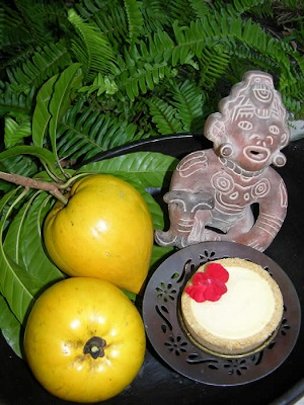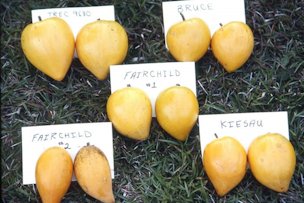From Fairchild Tropical Botanic Garden
by Noris Ledesma, Curator of Tropical Fruit
The Canistel, A Winter Fruit for South Florida
As published in the Miami Herald
The Mayans knew the value of the canistel back in 800 BC. They
would gather the maturing fruit from the dense evergreen trees that
shaded their thatch homes and place them in the cooled ashes of the
fire. Here they would ripen to a golden yellow and would be used as a
nourishing staple for everyday life.
Today this ancient fruit canistel (Pouteria campechiana) continues to prove its worth. It is in the sapote family and is well adapted to south Florida.

Growing Canistel in South Florida:
Producing
your own fruit in the home garden is easy. It will bloom and fruit
throughout the year depending on the variety and makes a perfect
landscape tree for the home garden. It is easy to grow, wind resistant,
and tolerant of sandy or limestone soils. And, oh yes, it will provide
bushels of fruit for the kitchen.

Canistel cultivars 
Producing
your own fruit in the home garden is easy. Look for grafted trees and
not seedlings. Seedling trees will grow well, but they will take many
years to fruit and will be of unknown and most likely inferior quality.
Grafted trees can be purchased from local tropical fruit nurseries and
specialty sales throughout South Florida.
Here are a few varieties recommended for planting:
‘Bruce’
is a large, uniform and atractive fruit shaped much like a
Hersey’s chocolate kiss (only yellow). Fruiting occurs in two
major waves during August to October and again from February to March.
There are 2 to 3 seeds in each fruit and plenty to eat.
‘Fairchild’
is a compact tree with slightly curved more elongated fruit. The
production is heavy and its timing is roughly the same as with the
previous variety.
‘Ross’
is distintive among the others selections. The fruit are flattened like
a hole-less doughnut and often is slightly flutted. The flesh is juicy
and there are from 3 to 5 seeds in the fruit. The tree is slow growing
and easy to control.
Canistel trees should be planted in the
full sun and will require watering until they get established if there
are inconsistent rains. Once established they are drought tolerant,
partially losing their leaves with the onset of extreme drought. They
respond well to mulching. Mulching improves water-holding capacity,
nutrient retention and availability, and soil structure.
The
Canistel is adapted well to life in the Caribbean and can be grown in
close proximity to the water. They are not salt tolerant, however and
will die with salt water inundation or persistent salt spray. Young
trees are cold-sensitive, and should be protected from frost or freezes.
Fertilization is best done with three applications per year (March, July and September) using 8-3-9 or other fruit tree formulation.
Pruning: Annual pruning of will trees at a manageable height and provide ready access to the fruit..
Harvest:
The fruit of canistel do not mature at the same time. The are yellow to
orange when they are mature and it is the time to be picked. The fruit
can be stored at room temperature for 3 to 10 days for ripening. As
they soften, the skin texture changes from glossy to dull. The ripe
fruit or the pulp can be preserved and stored by freezing it for up to
6 months.
The
skin and the flesh of the fruit is bright yellow
and stable over time. Neither heating nor freezing will darken the
bright yellow of the flesh and its texture makes it perfect for pies,
milkshakes puddings and bread.
Canistel is delicious when mixed with milk products,
making it perfect for milk shakes, ice creams and natural smoothies.
The fruit can be eaten fresh of course, but you must wait for the fruit
to fully ripen to a soft texture and peel away the thin yellow skin.
Immature fruit have sticky latex that is harmless, but sticky and
annoying. Added flavoring such as lime juice and honey may be added to
taste.
Back to
Canistel Page
|
|


